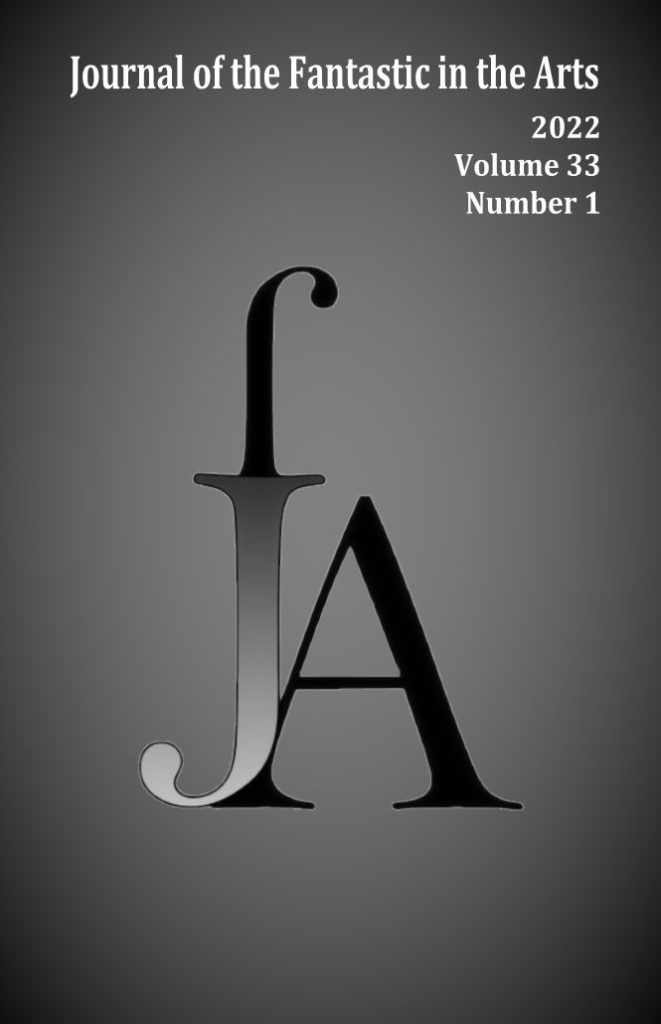
JFA 33.1 – Table of Contents
The JFA thanks the volunteers working under the former editorial administration for their work collecting, reviewing and building the content of this issue.
Images of Horror: Black Childhood as a Site of Resistance in Visual Media
Sara Austin
The Emotion of Dread in Cinematic Horror
Matthias De Bondt
Atomic Art and the Ecological Perspectives of David Lynch
Todd Tietchen
Han Song’s Weirdly Sublime Anti-Modernity
Ron Judy
REVIEWS
Kevin J. Wetmore Jr.’s The Conjuring (Devil’s Advocates)
Rev. by Zachary Doiron
Tison Pugh’s Harry Potter and Beyond: On J.K. Rowling’s Fantasies and Other Fictions
Rev. by Anna Lüscher
Christy Williams’s Mapping Fairy-Tale Space: Pastiche and Metafiction in Borderless Tales
Rev. by Alexandra Lykissas
Kyle A. Moody and Nicholas Yanes’s Hannibal for Dinner: Essays on America’s Favorite Cannibal on Television
Rev. by Kathleen Shaughnessy
Laurence Rickels’s Critique of Fantasy, Vol 1: Between a Crypt and a Datemark, Critique of Fantasy, Vol 2: The Contest Between B-Genres, and Critique of Fantasy, Vol 3: The Block of Fame
Rev. by Brian Willems
Abstracts
Sara Austin
Images of Horror: Black Childhood as a Site of Resistance in Visual Media
Child characters in Black horror interact with the monstrous as a means of resistance to racist violence. In this article, I examine how visual examples of Black horror, including the television series Lovecraft Country (2020), picture books Wee Winnie Witch’s Skinny (2004) and Precious and the Boo Hag (2005), and the film Us (2019),re-center Black child subjectivity from images of the body in pain onto community belonging by challenging both the audience and subject divides between the child and adult. These examples acknowledge that threats to Black subjectivity are continuous, but the family remains, grows, and passes on art and love to the next generation. This bringing-together of adults, children, families, and neighbors carries a powerful message of belonging and value as its own Radical Aesthetic within Black horror.
Austin, Sara. “Images of Horror: Black Childhood as a Site of Resistance in Visual Media.” Journal of the Fantastic in the Arts, vol. 33, no. 1, 2022, pp. 9–38.
Matthias De Bondt
The Emotion of Dread in Cinematic Horror
This article concerns itself with the cinematic emotion of dread. Within Horror Studies, cinematic dread has been theorized as a temporal emotion, mostly centered around the confrontation with the monstrous, after which dread evolves into other cinematic emotions of shock and/or horror. For this reason, the function of dread within the horror film experience is only recognized in relation to other emotions it should precede. However, this article argues that dread plays a crucial emotion in the affective workings of some horror films that fall under the term “dread-full” films. Through the close reading of two case studies, namely It Comes At Night and The Blackcoat’s Daughter, the article reasons that dread exists as an inseparable part of the viewing experience of these films and in doing so, argues that the emotion of dread is inherent to the overall cinematic horror experience.
De Bondt, Matthias. “The Emotion of Dread in Cinematic Horror.” Journal of the Fantastic in the Arts, vol. 33, no. 1, 2022, pp. 39–63.
Todd Tietchen
Atomic Art and the Ecological Perspectives of David Lynch
The work of David Lynch represents an essential engagement with the Anthropocene and its aesthetic forms. This is especially evident in the case of Twin Peaks, which integrates influences from multiple genres and the avant-garde into a complex mythopoeic treatment of planetary ecological crisis. Episode eight of Twin Peaks: The Return, with its Promethean title “Gotta Light?”, grounds Lynch’s mythopoesis in an origin story that builds upon foundational concepts regarding the Anthropocene, including its connections to the atomic age, its grounding suppositions in androcentrism, its complicity in cosmological violence, and the value of post-nature perspectives for understanding the (perhaps inescapably) precarious present.
Tietchen, Todd. “Atomic Art and the Ecological Perspectives of David Lynch.” Journal of the Fantastic in the Arts, vol. 33, no. 1, 2022, pp. 64–95.
Ron Judy
Han Song’s Weirdly Sublime Anti-Modernity
Han Song is a leading 21st-century Chinese science fiction author, but writes with great pathos about a modernity populated by monsters and perverse new social arrangements. From the aeronautical cannibalism of “The Passengers and the Creator” to the ghost labor of “Regenerated Bricks” and zombified workers of “My Fatherland Does Not Dream,” Han’s oeuvre repeatedly emphasizes the demented, and according to him “foreign” aspects of China’s passage into the globalized modernity. In this article I argue that, in the aforementioned novellas Han projects a consistent vision of a “weird modernity” that is at times deeply ethnocentric, localist, and reminiscent of the “Old Weird” authors of the early 20th-century (e.g., H.P. Lovecraft, Robert E. Howard, Seabury Quinn, and Clark Ashton Smith). Reading his work’s anti-modern pathos as a variant of weird fiction enables me to incorporate a Lacanian analysis of his racial others in terms of “enjoyment theft” borrowed from Slavoj Zizek. Han’s work is thus a gallery of unspeakable “sublime objects” that represent the weird potential and threat of modernity—i.e., it expresses China’s still deep-seated anxieties about “opening up” to an alien, non-Chinese “outside” world that seeks to steal, exploit, or subvert its desires.
Judy, Ron. “Han Song’s Weirdly Sublime Anti-Modernity .” Journal of the Fantastic in the Arts, vol. 33, no. 1, 2022, pp. 96–127.